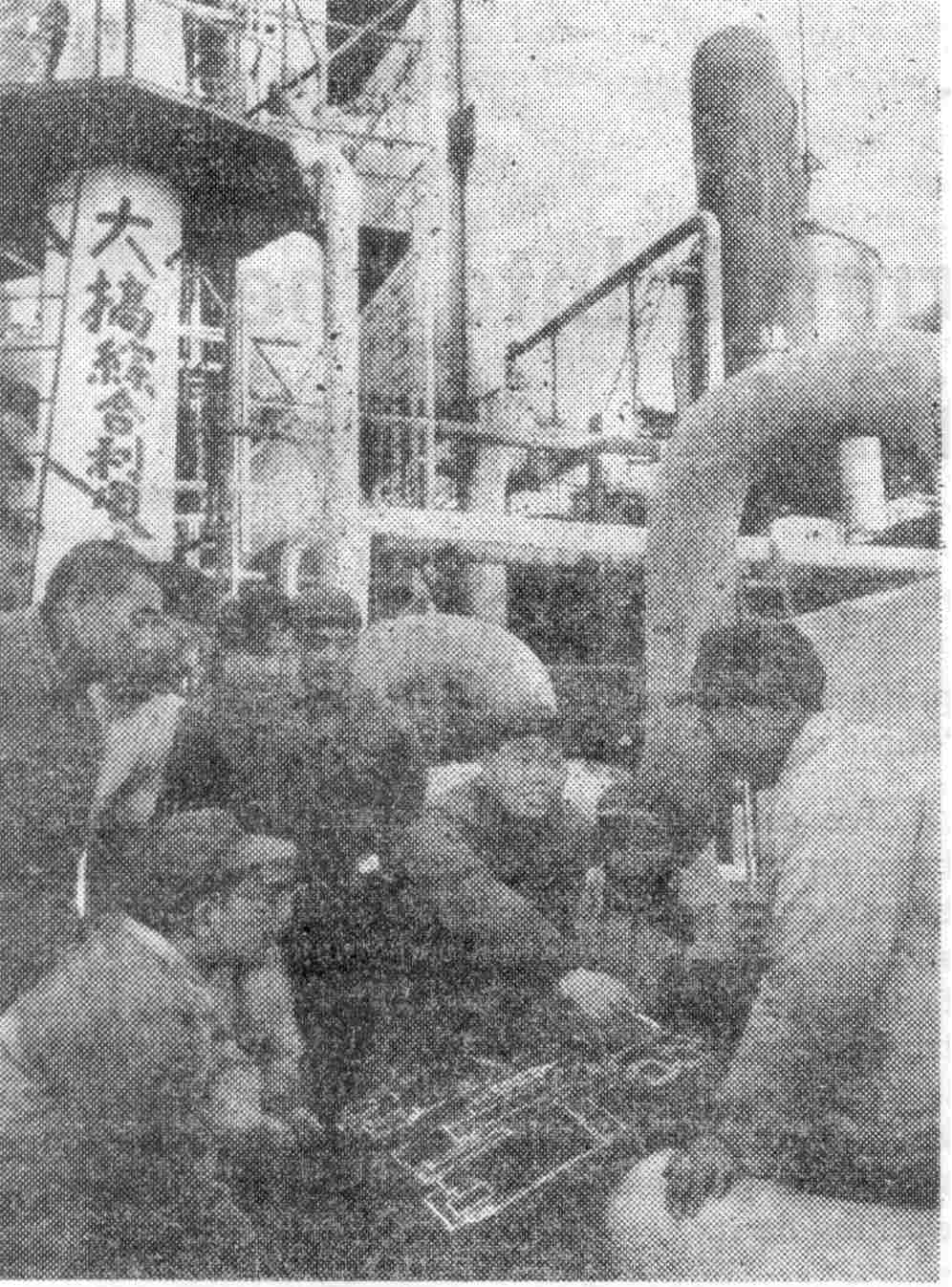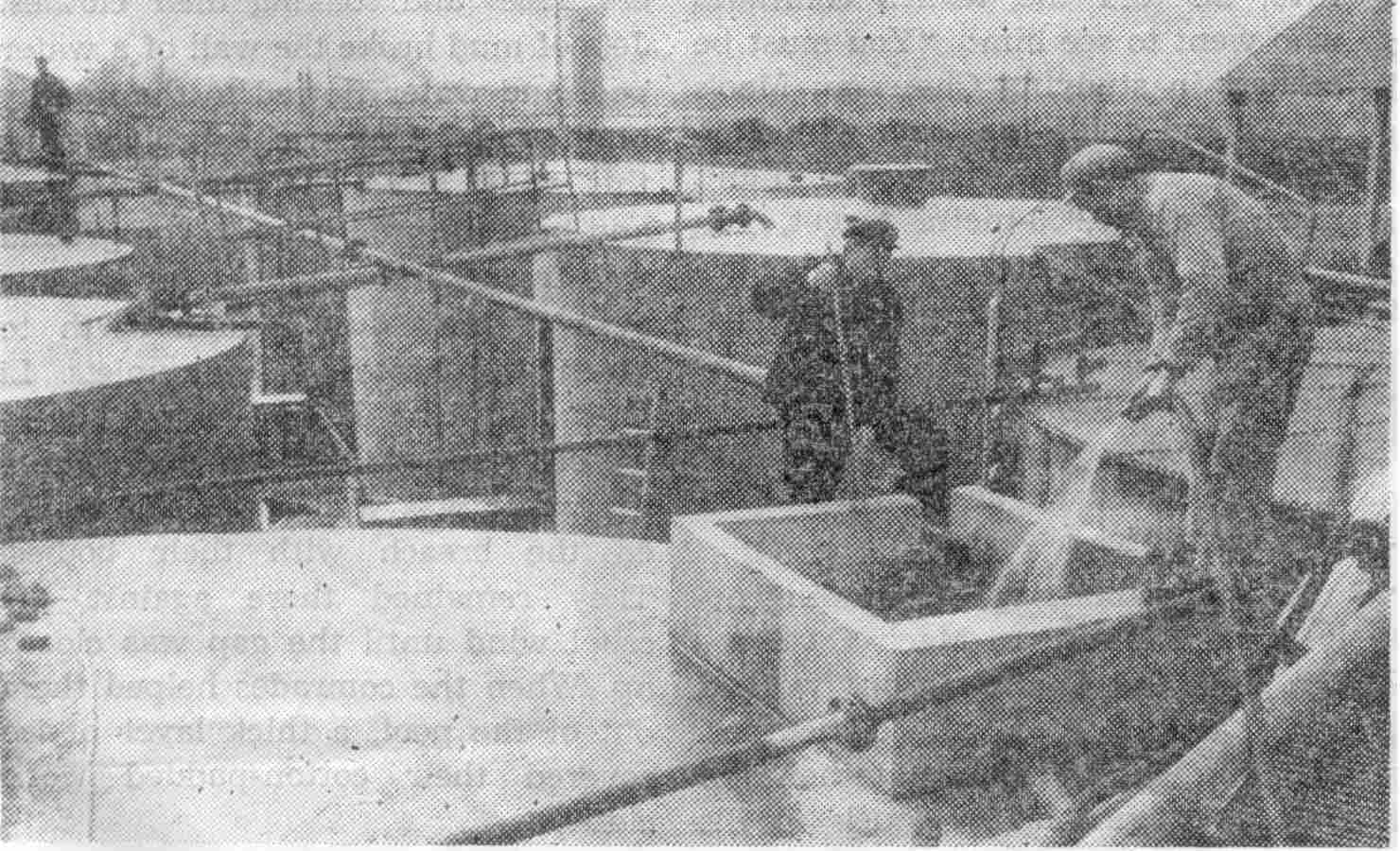
Shanghai Coking Plant workers studying how
to improve the technological processes in ex-
tracting chemical material from waste liquid.
[This article is reprinted from Peking Review, #4, Jan. 28, 1972, pp. 5-7.]
EVERY DAY large quantities of the “three wastes”—waste gas, liquid and residue—stream forth from industrial production. In capitalist countries, because the capitalists seek high profits and production is in a state of anarchy, these “wastes,” which pollute the air and poison the rivers, pose an increasingly serious menace to the people’s health. This has become an insoluble social problem in the capitalist world.
“How is pollution dealt with in China”? Some foreign friends who have seen the effects of pollution are very concerned about this question.
In our country, the “three wastes” have done little harm to the people. This is because in a socialist country like ours which is “proceeding in all cases from the interests of the people,” we can rely on the superiority of the socialist system to take various measures to prevent pollution harming the people.
As early as 1956, Chairman Mao put forward the principle of developing multi-purpose use. To carry out this principle is not only the fundamental way of preventing the “three wastes” from becoming harmful in the course of developing industry, but it will promote the development of the national economy. During the Great Proletarian Cultural Revolution, we criticized Liu Shao-chi’s counter-revolutionary revisionist line and the erroneous ideas resulting from the influence of the line which obstructed multi-purpose use. In recent years, a mass movement for multi-purpose use was launched on the industrial front. Relying on centralized Party leadership and the creative spirit of the masses, many cities and enterprises have gone in for large-scale multi-purpose use, eliminated the harmful and made effective use of the beneficial. From the “three wastes” they have recovered and extracted large quantities of raw materials for and products of metallurgical, chemical, light industry, textile and building departments. This has not only helped increase production but has improved urban and suburban sanitation and protected the people’s health.
The aim of socialist industrial production is not profits but the prosperity of the country and the people’s happiness. The capitalist practice of only seeking profit while ignoring the harm done to the people by the “three wastes” is alien to socialism.
We consider preventing the “three wastes” from harming the people and turning the harmful into the beneficial as an indispensable factor in industrial construction, from city planning, arranging and selecting factory sites to technological processes. A new industrial enterprise is not allowed to go into production if it lacks necessary measures to deal with the “three wastes” properly. Old enterprises which have not yet solved the problem of the “three wastes” are actively working on it.
Waste water containing phenol from the General Chemical Plant of the Anshan Iron and Steel Company, which is an old enterprise, used to damage crops and aquatic products and endanger people’s health. Is it necessary to remove phenol from waste water? The masses of the workers and poor and lower-middle peasants said it was absolutely necessary and pledged to do so. The capitalist roaders said that they could not do it because it was a losing business.
During the Great Cultural Revolution, the plant’s revolutionary committee organized all its staff members and workers to study Chairman Mao’s teachings and mercilessly criticize the revisionist line, including trash like “making great efforts to do what is most profitable, less efforts to do what is less profitable and no efforts to do what is unprofitable” and “putting profits in command,” advertised by Liu Shao-chi. They saw the question of whether or not to remove phenol as a question of “for whom?” which is a matter of principle, and one of whether or not they want to support agriculture and consolidate the worker-peasant alliance. After reaching unity in their thinking and pooling their collective wisdom and strength, they quickly made a device for removing phenol from waste water, thus turning the harmful into the beneficial.

Shanghai Coking Plant workers studying how
to improve the technological processes in ex-
tracting chemical material from waste liquid.
Socialist enterprises are different from capitalist enterprises. The nature of the former determines that they cannot take into account the economic aspect only without considering the political aspect, or the interests of their own units without considering the needs of the whole. In carrying out multi-purpose use, workers in the Anhwei General Textile Printing and Dyeing Mill, after criticizing the erroneous views which regarded handling waste water as an extra burden and unprofitable, arrived at a clear understanding that socialist national economy is an integrated whole. Whether something is profitable or without profit must be judged from the interests of the whole. Something which may not be profitable for an enterprise can be profitable to the whole. In the revolutionary spirit of doing anything of benefit to the people, the workers worked in concert with commune members and agricultural college teachers and students to turn poisonous material into fertilizing silt by oxidating and dissolving micro-organisms. After repeated experiments, they successfully carried out biochemical treatment of waste water from the printing and dyeing mill.
Apart from eliminating pollution, multi-purpose use is an important economic policy in China’s socialist construction. The big efforts going into it will make it possible to utilize all resources to the fullest. The principle of multi-purpose use is applied in designing and building new factories as well as in the technical transformation of old factories. While mainly making one product, factories develop a diversified economy.
Multi-purpose use in China’s largest industrial city Shanghai developed rapidly under the leadership of the revolutionary committees at various levels and a unified plan as well as by freely mobilizing the masses. Since there are many industrial districts in the city and factories in some districts are relatively concentrated, the city first concentrated efforts on the Peihsinching, Wusung, Taopu and Nanhsiang industrial districts where the “three wastes” were comparatively more. At the same time, it organized co-ordination between factories to speed up the battle against the “three wastes.” The Shanghai Resin Factory and Liaoyuan Chemical Works and 27 other factories in the Peihsinching District jointly raised more than 200 suggestions on utilizing wastes. Up to now over 90 suggestions have been put to use and more than 200 tons of raw and other materials recovered. In producing chloromethyl methyl ether, the Shanghai Resin Factory needed a large amount of sulphuric acid and hydrochloric acid. Co-operating with the Liaoyuan Chemical Works, the resin factory now uses a certain kind of waste gas from the chemical works to produce chloromethyl methyl ether. As a result, not only is the waste gas used, but this saves more than 4,000 tons of sulphuric acid and hydrochloric acid for the state.
From practice people understand that multi-purpose use can be developed in a big way. Last year, the city’s industrial departments got 1.4 million tons of different chemical materials out of waste liquid, the percentage of industrial residue used reached 70 and 20 to 30 kinds of valuable and rare metals were obtained from the “three wastes.”
By relying on their own efforts and local methods and working hard for 40 days, the Hungchi Paper Mill in Hangchow’s suburbs built a workshop producing 200 tons of ammonium humate a day by utilizing the waste liquid from paper making. Ammonium humate not only can be used as a fertilizer but as an insecticide which benefits nearby farmland.
After studying Chairman Mao’s philosophical works, the masses of workers, peasants and soldiers have increased their knowledge, broadened their view and raised their ability of knowing and transforming the world. Workers in a chemical plant used to think that the “three wastes” could only be sent out into the atmosphere, got rid of by underground pipes or emptied into the seas. By studying materialist dialectics they came to know that the method of one dividing into two could also be applied to “waste materials” which could be transformed into valuable things under certain conditions. So they enthusiastically devoted themselves to multi-purpose use. Consciousness is transformed into matter. In the past few years, they have produced poly-crystalline silicon, silicon oil, diodes and other products.
There is no limit to people’s ability to know and transform the objective world. Thus there is no limit to utilizing the “three wastes.” Using cotton seeds as its material, a plant used to treat the seed shells as fuel. Later, workers produced furfural from the shells, acetone from the gas emitted in making furfural, glucose out of the residue and glycerin, butanol, alcohol and weiching (a flavouring essence) out of the glucose residue. Indeed, there are no limits. They believe every thing is valuable; there are only materials which have not been utilized, and there is no absolute waste which cannot be utilized. Continued scientific experiments have yielded important material from remaining “waste.”
The principle of multi-purpose use is going deeper into people’s minds and being translated into the actions of millions upon millions of people. Great attention has been or is being paid to multi-purpose use in every field, from the processing industry to mining and metallurgy, from heavy industry to light industry and from industry to trade.
The unfolding of multi-purpose use soon broke the old division of labour between different industrial segments and the demarcation line between different lines of endeavour and enterprises. A factory is divided into several, one raw material is used in many ways, a piece of machinery is used for many purposes, one worker is capable of many kinds of work apart from his specialization, and a factory can produce many things while engaging mainly in one product. All this gets better results from limited manpower, equipment and resources. Utilizing its own “three wastes,” the Talien Steel Mill built by its own efforts ten small factories which turn out over 20 different products. The Peking Winery uses its “three wastes” to trial-produce hydrogen, chlorine gas, helium, polycrystalline silicon, adenosine triphosphate, 4-24 bacterial insecticide and a plant hormone, thereby combining light, chemical and electronics industries and products for supporting agriculture.
The multi-purpose use campaign has mobilized every possible force and promoted the development of local small industries. Many cities, counties and enterprises have organized retired workers, housewives and others not in the regular labour force to use “wastes” from the big plants as raw materials. Small factories run by neighbourhoods, schools, counties, cities or production teams were set up by self-reliance. Some small factories have turned out advanced products.
The masses in, the Tangku District in Tientsin have set up dozens of small chemical works making scores of chemicals by utilizing the “three wastes” of the big plants. The muddy water from the Tientsin Soda Works was used by a small factory to produce calcium chloride; the waste in producing calcium chloride was used by another small factory to produce salt for industrial purposes; and the residue was utilized by still another small unit, a middle school-run factory, to produce sodium chloride which is used as a reagent. Everything was turned to good use.
Workers from trade departments in cities and towns have gone to factories, neighbourhoods and villages in search of “wastes.” They either processed it or supplied it to small factories as raw materials.
* * *
The principle of multi-purpose use correctly reflects the objective law of the development of production. Under the socialist system where the labouring people are the masters, mastering and using this law not only can end pollution, but also can expand production on a wide scale, creating ever more wealth for the state. At present, China’s production technique is comparatively backward and multi-purpose use has just started. Under the guidance of Chairman Mao’s revolutionary line, multi-purpose use will surely be developed on an ever wider scale.

The Tungfeng Paper Mill in Chekiang Province
producing ammonium humate from waste liquid.
Return to Peking Review article list